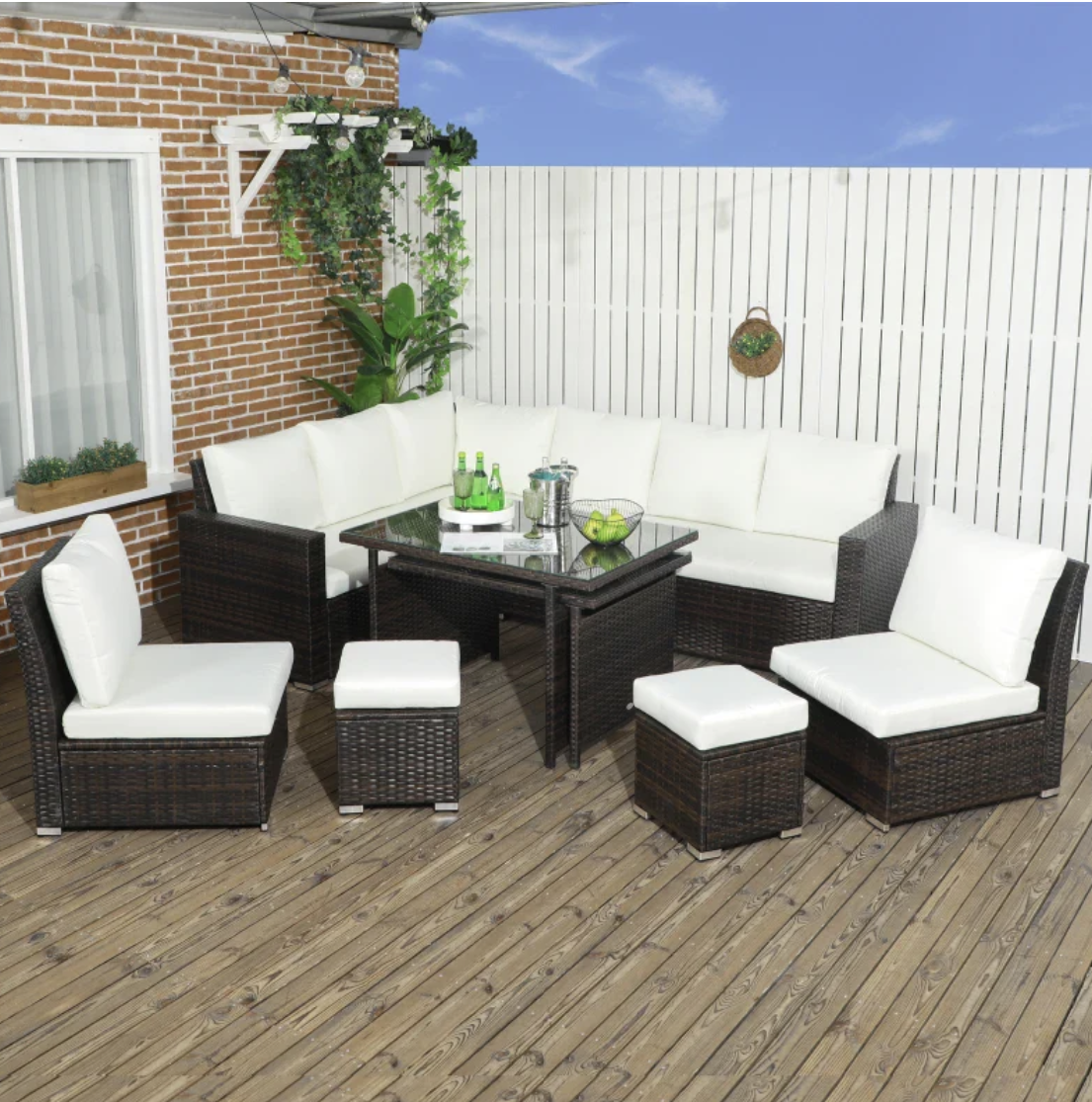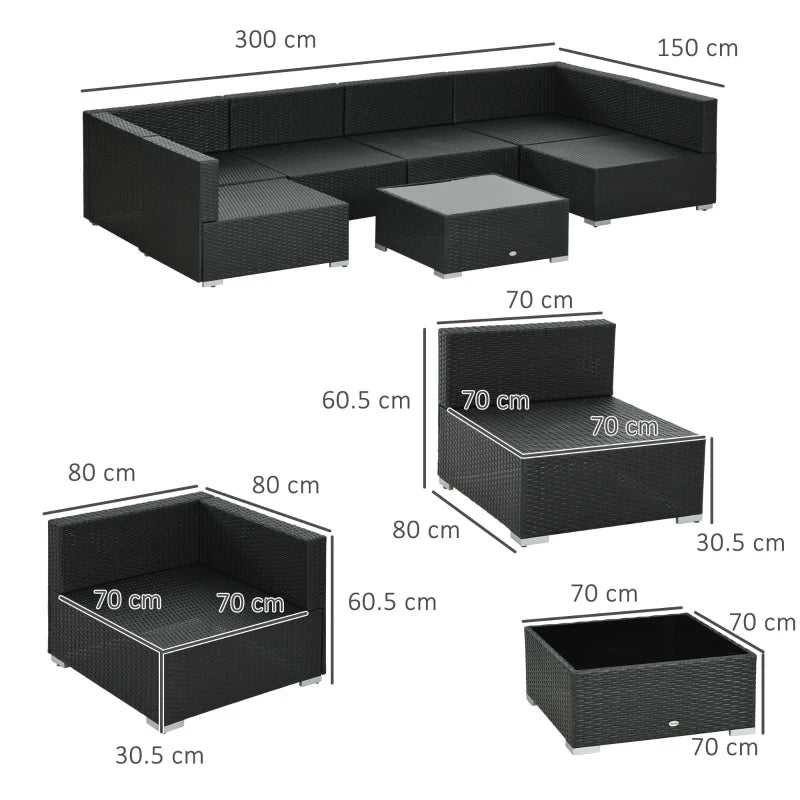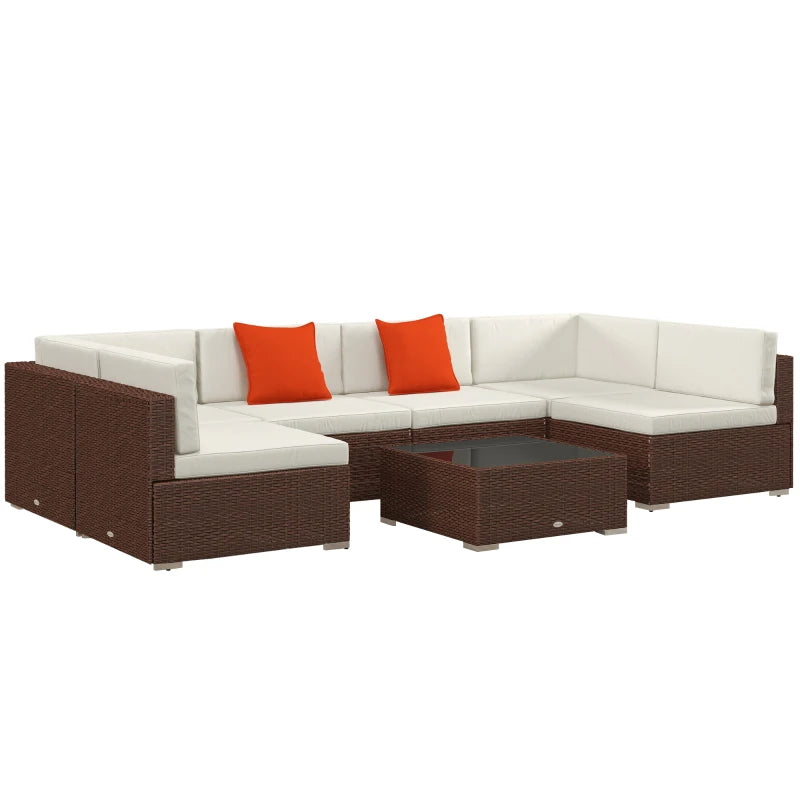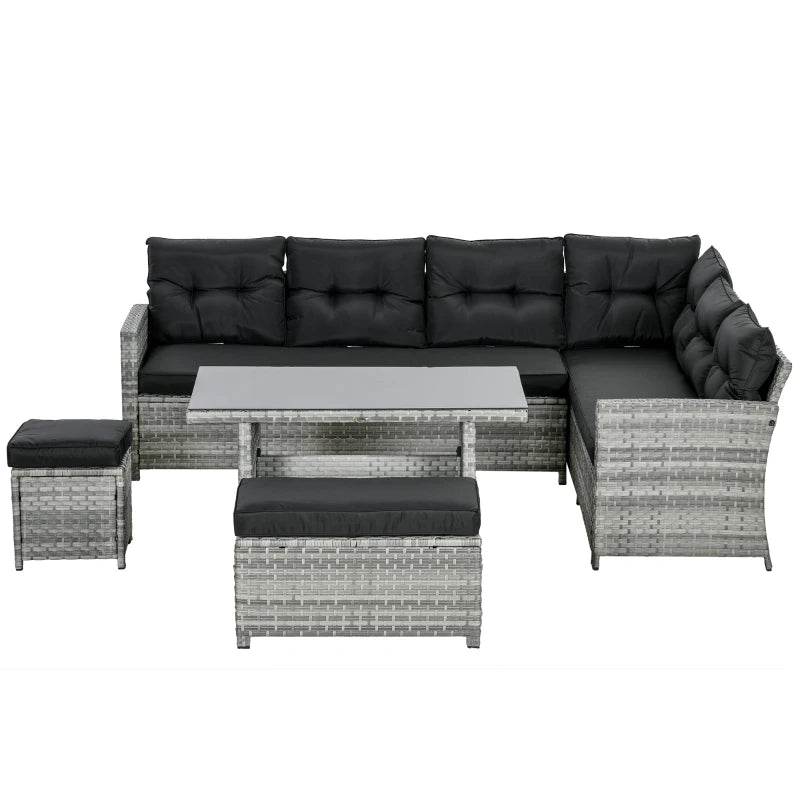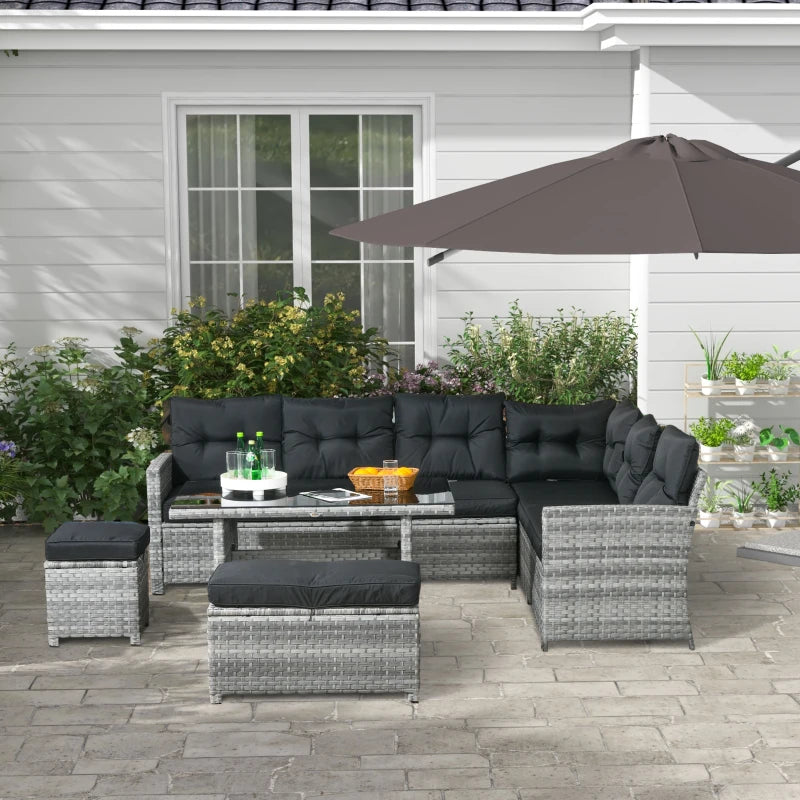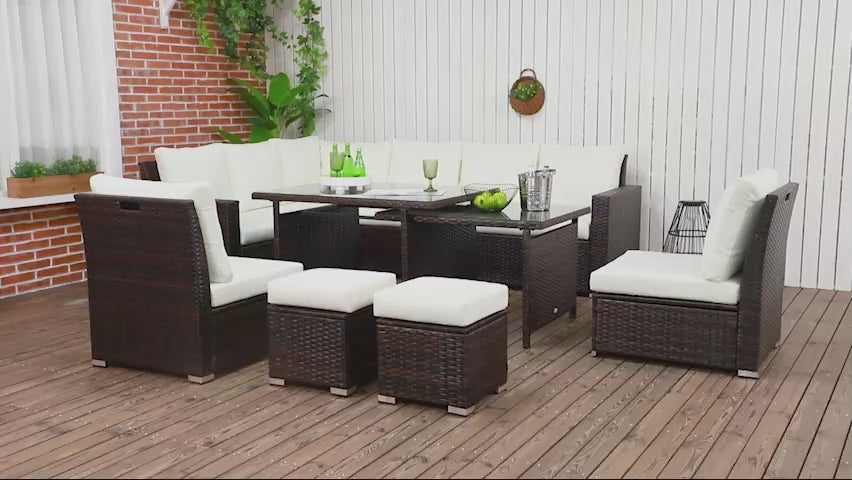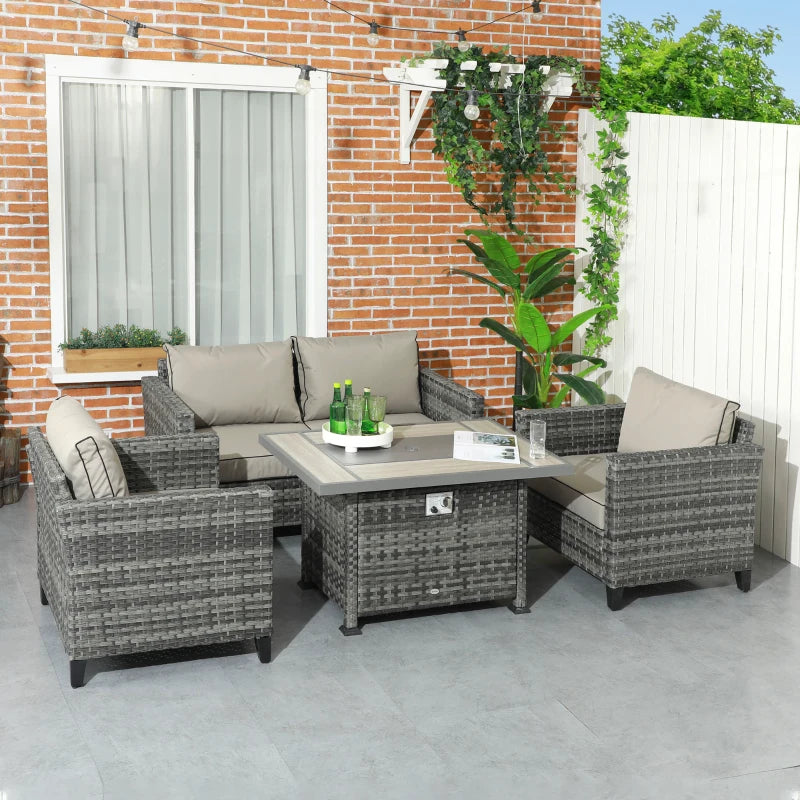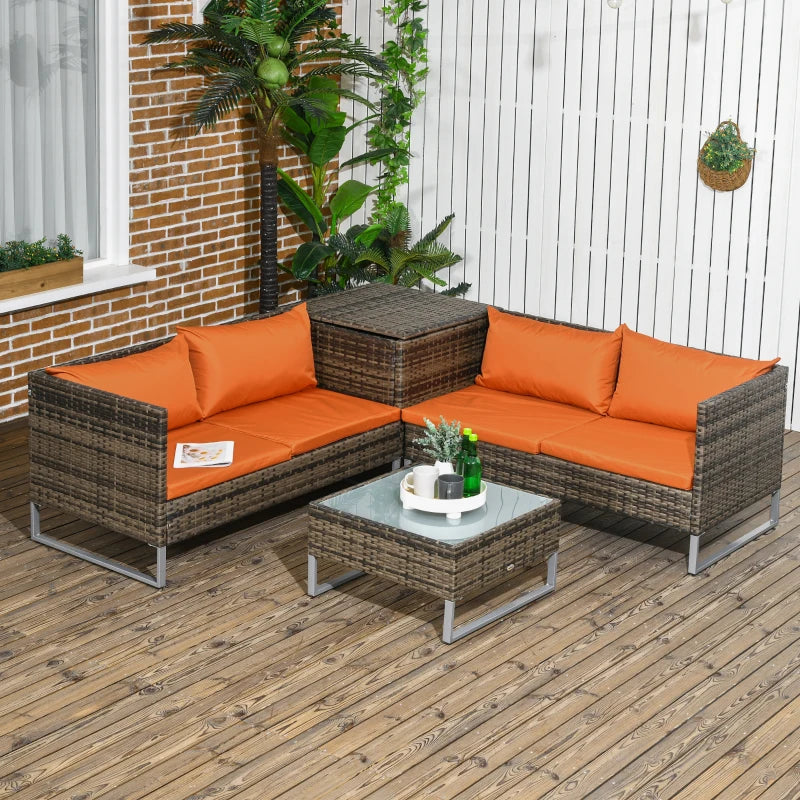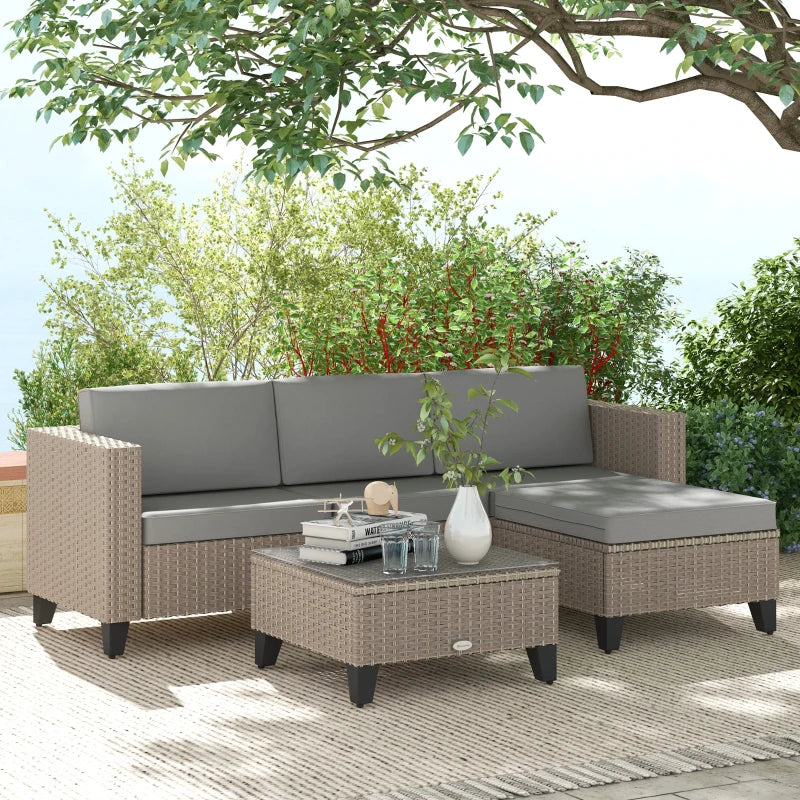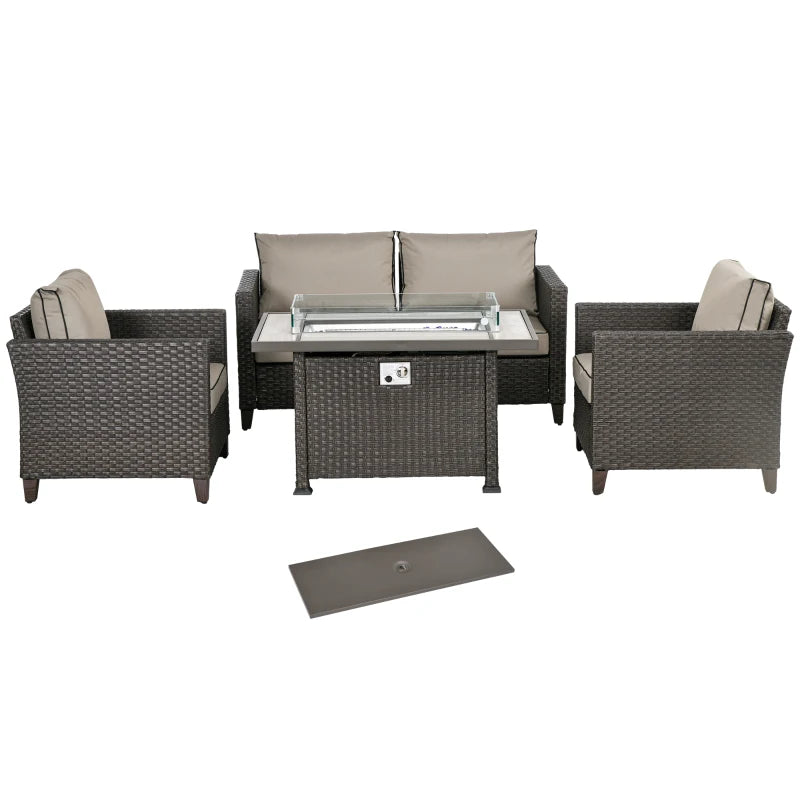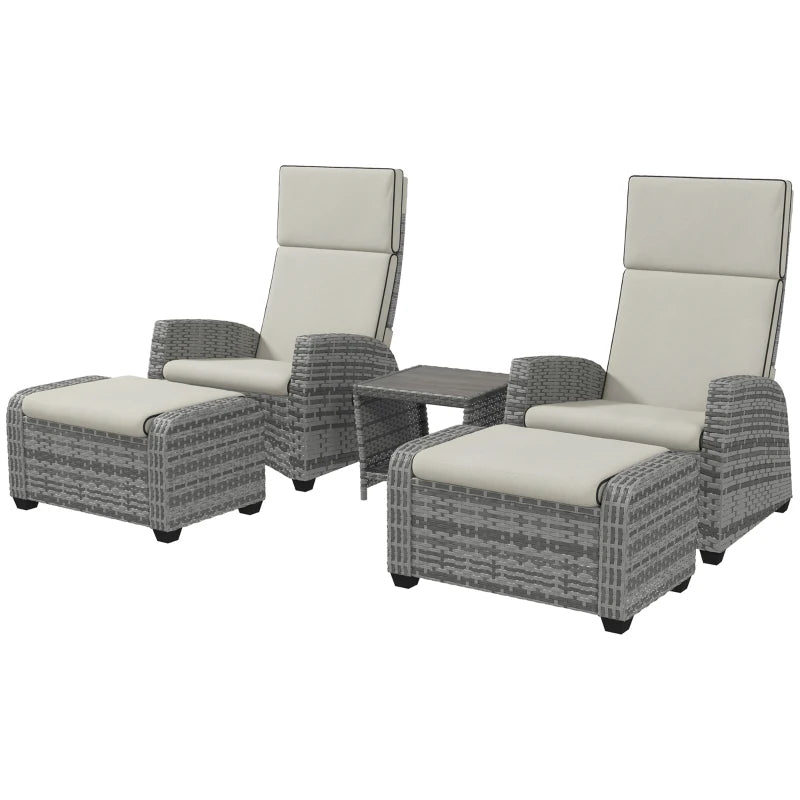Rattan furniture is a timeless choice, loved for its ability to look good in any outdoor garden setting.
Whether you have a rattan dining set, rattan bistro set or full sofa set, regular cleaning and maintenance are key to keeping it in excellent condition.
Over time, dust, spills, and even mildew can take a toll on its appearance. But don’t worry—cleaning rattan is easier than you think!
As a leading UK supplier of rattan garden furniture, we’ll take you through the best ways to clean, maintain, and protect your rattan furniture so it stays beautiful for years to come.
Understanding Rattan: Natural vs. Synthetic
Before covering cleaning techniques, it’s important to know what type of rattan furniture you have. This determines how you should care for it.
✅ Natural Rattan: Made from woven palm stems, this type is sturdy but sensitive to excess moisture. It’s commonly used indoors or in covered outdoor spaces.
✅ Synthetic Rattan: Designed to mimic natural rattan, this is made from resin or plastic and is more weather-resistant, making it ideal for outdoor use.
Both types require cleaning, but natural rattan needs extra care to prevent cracking, warping, or mould growth.
Tools & Materials You’ll Need 🧼
Gather these essentials before you begin:
✔️ Soft cloths (microfiber works best)
✔️ Mild dish soap or eco-friendly detergent
✔️ Soft-bristle brush or an old toothbrush
✔️ Vacuum with a brush attachment
✔️ Compressed air (for hard-to-reach crevices)
✔️ White vinegar (for stubborn stains & mildew)
✔️ Warm water
✔️ Protective gloves
Step-by-Step Guide to Cleaning Rattan Furniture
1️⃣ Regular Dusting & Light Cleaning (Weekly)
Here’s how to dust rattan furniture the right way:
✔️ Vacuum First: Use a vacuum with a soft brush attachment to gently lift dust from the surface without damaging the weave. Move in the direction of the rattan strands to avoid loosening them.
✔️ Target Hard-to-Reach Areas: For tight crevices, compressed air (like the kind used for cleaning keyboards) is excellent for blowing out dust from the deeper layers. Alternatively, use a soft-bristle brush or an old toothbrush to dislodge stubborn debris without fraying the weave.
✔️ Wipe Down for a Refresh: Once the dust is removed, take a damp microfiber cloth and gently wipe the surface to remove any remaining fine particles. Avoid excess water, as it can seep into the weave and cause natural rattan to swell or weaken.
✔️ Don't Forget Underneath! Dust and dirt accumulate on the undersides of rattan furniture, especially garden dining chairs and tables. Flip the furniture or get underneath with the vacuum to keep all surfaces clean.
How Often Should You Dust Rattan?
- Indoor Rattan: Once a week to prevent dust buildup.
- Outdoor Rattan: Every few days due to increased exposure to pollen, dirt, and weather elements. Especially in the summer months.
Why It Matters:
A consistent dusting routine protects the integrity of rattan fibers, extends the furniture’s lifespan, and reduces the need for deep cleaning.
Think of it as small maintenance steps that prevent major restoration work down the line.
Want to take your dusting routine a step further? Simply apply a light coat of furniture wax or lemon oil every few months to help repel dust and keep rattan strands nourished and flexible! ✨

Rattan chairs, supplied by Trade Warehouse in 2-3 days. FREE delivery.
2️⃣ Deep Cleaning for Stains & Dirt (Monthly or as needed)
Even with regular dusting, rattan furniture will likely accumulate grime, stains, and oils over time.
A thorough clean is essential to maintain its natural beauty and prevent dirt from settling into the weave.
However, as rattan is a woven, porous material, it requires a gentle but effective cleaning approach to avoid damage.
Follow these expert steps for a proper deep clean:
Prepare a Gentle Cleaning Solution
✔️ Fill a bowl with warm water and add a few drops of mild dish soap or eco-friendly detergent.
✔️ Stir the mixture until bubbles form—this ensures the soap is evenly distributed without making the water too concentrated.
✔️ Avoid strong chemicals like bleach or ammonia, as they can weaken natural rattan fibers, strip away protective coatings, and cause fading.
Scrub Carefully to Remove Embedded Dirt
✔️ Dip a soft-bristle brush or old toothbrush into the soapy solution, then lightly scrub the surface.
✔️ Focus on woven crevices and intricate details where dust and grime tend to accumulate.
✔️ For stubborn dirt, use a microfiber cloth wrapped around your fingertip to get into smaller gaps without damaging the weave.
💡 Pro Tip: If you're cleaning outdoor synthetic rattan furniture, you can use a sponge or a soft brush with slightly firmer bristles, as synthetic materials are more resistant to water exposure.

Wipe & Dry to Prevent Moisture Damage
✔️ Use a damp microfiber cloth (rinsed in clean water) to remove any soapy residue.
✔️ Immediately dry the furniture with a soft towel to prevent excess moisture from soaking into the strands.
✔️ For natural rattan, place the furniture in a well-ventilated area to air dry completely before use. Avoid direct sunlight, as this can cause warping or cracking.
🚫 Important: Never soak rattan furniture in water! Unlike plastic or metal, rattan absorbs moisture, which can lead to swelling, weakening, and even mould growth. Always use minimal water and dry it thoroughly after cleaning.
How Often Should You Deep Clean Rattan?
- Light-use indoor rattan: Every 2-3 months for maintenance.
- Heavily used indoor rattan (rattan dining sets, coffee tables): Once a month to keep stains from setting.
- Outdoor rattan: Every few weeks, as exposure to rain, dust, and humidity makes it more prone to dirt buildup.
3️⃣ Removing Stubborn Stains & Mildew
Mildew and dark stains can quickly ruin the look of rattan furniture, especially in humid environments or outdoor settings.
Because rattan is a natural material, it’s highly absorbent, making it more susceptible to moisture-related issues. If you spot dark patches or mildew, act fast to prevent permanent damage.

Cosy rattan ensemble, supplied by Trade Warehouse in 2-3 days delivery.
🍃 Natural Mildew Removal Method
✔️ Mix a gentle cleaning solution – Combine one part white vinegar with four parts water to create a safe but effective mildew remover.
✔️ Apply the solution – Dampen a soft cloth or sponge with the mixture and gently blot the affected area. Avoid over-saturating the rattan.
✔️ Scrub gently – Use a soft-bristle brush or an old toothbrush to work the solution into crevices where mildew tends to grow.
✔️ Wipe away residue – Take a clean damp cloth and wipe the area thoroughly to remove any leftover vinegar solution.
✔️ Let it dry completely – Air-dry the furniture in a well-ventilated space, preferably outdoors but out of direct sunlight to prevent warping.
💡 Why Vinegar? White vinegar is a natural antifungal agent that kills mildew without the harsh effects of bleach, which can weaken rattan fibers over time.
🚨 Dealing with Tough Stains & Persistent Mildew
If the vinegar solution doesn’t fully remove mildew stains:
✔️ Try a baking soda paste – Mix baking soda with a few drops of water to create a paste, apply to the stain, let sit for 10 minutes, then gently scrub and wipe clean.
✔️ Use a mild bleach solution (only for synthetic rattan!) – Mix 1 tablespoon of bleach per litre of water, apply sparingly with a sponge, scrub lightly, and rinse well.
✔️ Apply a lemon juice treatment – The natural acidity of lemon juice can lift stains and freshen up rattan. Apply directly and let sit before wiping away.
🚫 Avoid using harsh chemical cleaners like ammonia, as they can dry out and weaken natural rattan.
💦 Preventing Future Mildew Growth
✔️ Keep rattan furniture in a dry environment – Moisture is the enemy of natural rattan. Store outdoor pieces in a covered area during wet seasons.
✔️ Apply a water-repellent spray – A clear, breathable sealant or furniture wax can protect rattan from excess moisture.
✔️ Improve air circulation – Place furniture in an area with good airflow to prevent dampness from settling into the weave.
✔️ Use cushions or covers – Not only do they add comfort, but they also protect rattan from direct exposure to rain and spills.
By addressing mildew as soon as it appears and following these preventative measures, you can keep your rattan furniture looking fresh, clean, and mildew-free all year long! 🌿✨
Seasonal Care Tips to Keep Rattan Looking New
Seasonal changes can impact the condition of rattan if not properly maintained.
Whether indoors or outdoors, exposure to sunlight, moisture, and temperature fluctuations can cause fading, cracking, or mildew growth.
To keep your rattan furniture in excellent shape all year round, follow these seasonal care strategies.
🌞 Indoor Rattan: Protecting Against Dryness & Fading
While indoor rattan furniture is less exposed to harsh weather, indoor environments can still cause wear and tear over time. Here's how to protect it:
✔️ Keep it away from direct sunlight – Too much exposure to sunlight can fade the colour and dry out the fibers, leading to cracking. Position your rattan furniture away from large windows or use curtains and blinds to reduce direct exposure.
✔️ Maintain humidity levels – Rattan is a natural material that thrives in moderate humidity. If your home is too dry (especially in winter when heating is on), consider using a humidifier to prevent brittleness and cracking. On the flip side, avoid placing rattan furniture in damp areas where excess moisture can lead to mould or mildew.
✔️ Use cushions and seat pads – Direct weight and friction can wear down the surface of rattan over time. Adding cushions, throws, or seat pads not only enhances comfort but also reduces wear on the woven strands, helping the furniture last longer.
✔️ Dust regularly – Even indoors, rattan collects dust that can settle into its crevices. Vacuum with a brush attachment or use a soft cloth to prevent buildup that could eventually lead to grime.
🌧️ Outdoor Rattan: Weatherproofing Against Rain & Sun
Outdoor rattan furniture faces the biggest challenges—from intense sun exposure in summer to rain and humidity during colder months.
✔️ Store it indoors or under a cover during winter – If possible, move rattan furniture into a shed, garage, or indoor space during cold and wet months. If storage isn't an option, invest in waterproof, breathable covers to shield it from rain, snow, and frost.
✔️ Wipe it down after rain – Rattan is naturally absorbent, meaning excess moisture can cause warping or mildew growth. If your furniture is exposed to rain, wipe it dry as soon as possible with a soft towel or cloth. For synthetic rattan, which is more water-resistant, this is still a good practice to prevent dirt buildup.
✔️ Rotate furniture to ensure even exposure – If your rattan furniture sits in the same position all season, one side may fade faster than the other due to uneven sun exposure. Rotate chairs and tables every few weeks to keep the colour and material evenly weathered.
✔️ Apply UV-resistant spray – Prolonged sun exposure can cause rattan to dry out and weaken. A UV-protective spray (designed for natural materials) adds a layer of protection and helps preserve the flexibility of the fibers.
✔️ Keep it off damp surfaces – Place outdoor rattan furniture on patios, decking, or outdoor rugs instead of directly on grass or soil, where constant exposure to dampness can weaken the legs and structure over time.
Year-Round Rattan Care: A Few Extra Pro Tips
✔️ Clean spills immediately – Whether it’s a glass of wine indoors or rainwater outdoors, don’t let liquid sit on rattan for too long. Blot with a clean cloth and allow to air-dry completely.
✔️ Check for loose strands and fix them early – If you spot any fraying or loose weaves, secure them with a dab of wood glue before they get worse.
✔️ Oil or wax natural rattan occasionally – To prevent drying and cracking, apply a light coat of furniture wax or lemon oil every few months to keep the fibers flexible.
By following these seasonal care steps, your rattan furniture will stay strong, stylish, and weather-resistant for years to come! 🌿✨
Preventative Care: Keep Rattan Furniture in Top Condition
🛑 Avoid placing heavy objects on rattan to prevent sagging.
🛑 Don’t drag furniture—lift and move it carefully.
🛑 Use furniture wax or lemon oil for added shine and protection.
🛑 Check joints and screws every few months and tighten if needed.
Final Thoughts: A Little Care Goes a Long Way
Rattan furniture is a timeless investment, but like any well-loved piece, it needs consistent care to stay beautiful and functional.
Whether indoors or outdoors, this natural material responds to its environment—too much moisture can lead to mildew, too much dryness can cause brittleness, and sun exposure can fade its colour.
The secret to keeping rattan furniture in top condition is balance—moderate cleaning, mindful storage, and proactive maintenance.
By incorporating simple but effective habits, such as regular dusting, deep cleaning when needed, and protecting it from extreme weather conditions, you can extend the life of your rattan furniture significantly.
A few minutes of care every week prevents the need for costly repairs or replacements down the line.
Below is a quick reference guide to ensure you’re giving your rattan furniture the best possible care throughout the year:
📝 Rattan Furniture Care Cheat Sheet
| Care Task | How Often? | Best Practices |
|---|---|---|
| Dusting 🧹 | Weekly | Use a vacuum with a brush attachment and a microfiber cloth to prevent dust buildup. |
| Deep Cleaning 🛁 | Every 2-3 months | Use mild soap and warm water with a soft-bristle brush; avoid soaking rattan. |
| Mildew Removal 🌱 | As needed | Dab white vinegar solution onto stains, scrub gently, and allow to air dry. |
| Indoor Protection 🏡 | Ongoing | Keep away from direct sunlight, maintain humidity levels, and use cushions to prevent wear. |
| Outdoor Care 🌦 | Seasonally | Store under cover in winter, wipe down after rain, and apply UV-protection spray. |
| Repairs & Fixes 🔧 | As needed | Secure loose weaves with wood glue, repaint or re-varnish faded rattan, and keep furniture off damp surfaces. |
What’s Next? Your Rattan Care Action Plan
Now that you have a solid understanding of how to clean, protect, and maintain your rattan furniture, it’s time to put these steps into action.
✔️ Set a cleaning schedule—whether weekly for dusting or seasonally for deep cleaning, make it part of your routine.
✔️ Invest in protective measures—cushions, covers, and water-repellent sprays go a long way in preserving your furniture.
✔️ Act fast on stains and mildew—the sooner you tackle them, the easier they are to remove.
✔️ Rotate and reposition outdoor furniture—keep sun exposure and wear even.
Rattan furniture is all about effortless beauty with the right upkeep.
💬 Have any rattan cleaning tips or tricks of your own?
Share them in the comments! We’d love to hear what works for you! 🌿✨

